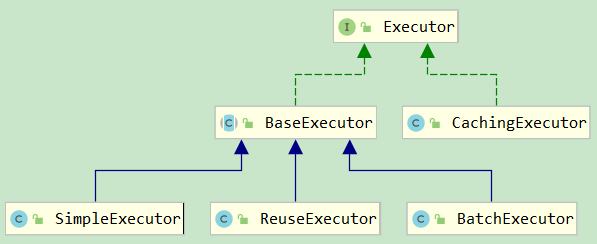mybatis 源码分析(三)Executor 详解
本文将主要介绍 Executor 的整体结构和各子类的功能,并对比效率;
一、Executor 主体结构
1. 类结构
executor 的类结构如图所示:

其各自的功能:
- BaseExecutor:基础执行器,封装了子类的公共方法,包括一级缓存、延迟加载、回滚、关闭等功能;
- SimpleExecutor:简单执行器,每执行一条 sql,都会打开一个 Statement,执行完成后关闭;
- ReuseExecutor:重用执行器,相较于 SimpleExecutor 多了 Statement 的缓存功能,其内部维护一个
Map<String, Statement>,每次编译完成的 Statement 都会进行缓存,不会关闭; - BatchExecutor:批量执行器,基于 JDBC 的
addBatch、executeBatch功能,并且在当前 sql 和上一条 sql 完全一样的时候,重用 Statement,在调用doFlushStatements的时候,将数据刷新到数据库; - CachingExecutor:缓存执行器,装饰器模式,在开启二级缓存的时候。会在上面三种执行器的外面包上 CachingExecutor;
2. Executor 的生命周期
初始化:
// DefaultSqlSessionFactory
private SqlSession openSessionFromDataSource(ExecutorType execType, TransactionIsolationLevel level, boolean autoCommit) {
Transaction tx = null;
try {
final Environment environment = configuration.getEnvironment();
final TransactionFactory transactionFactory = getTransactionFactoryFromEnvironment(environment);
tx = transactionFactory.newTransaction(environment.getDataSource(), level, autoCommit);
final Executor executor = configuration.newExecutor(tx, execType);
return new DefaultSqlSession(configuration, executor, autoCommit);
} catch (Exception e) {
closeTransaction(tx); // may have fetched a connection so lets call close()
throw ExceptionFactory.wrapException("Error opening session. Cause: " + e, e);
} finally {
ErrorContext.instance().reset();
}
}
关闭:
public void close() {
try {
executor.close(isCommitOrRollbackRequired(false));
dirty = false;
} finally {
ErrorContext.instance().reset();
}
}
所以 Executor 的生命周期和 SqlSession 是一样的,之所以要明确的指出这一点是因为 Executor 中包含了缓存的处理,并且因为 SqlSession 是线程不安全的,所以在使用 Executor 一级缓存的时候,就很容易发生脏读;后面还会通过具体示例演示;
3. query 方法
@Override
public <E> List<E> query(MappedStatement ms, Object parameter, RowBounds rowBounds, ResultHandler resultHandler) throws SQLException {
BoundSql boundSql = ms.getBoundSql(parameter); //获取绑定的sql
CacheKey key = createCacheKey(ms, parameter, rowBounds, boundSql); // hash(mappedStementId + offset + limit + sql + queryParams + environment)
return query(ms, parameter, rowBounds, resultHandler, key, boundSql);
}
@SuppressWarnings("unchecked")
@Override
public <E> List<E> query(MappedStatement ms, Object parameter, RowBounds rowBounds, ResultHandler resultHandler, CacheKey key, BoundSql boundSql) throws SQLException {
ErrorContext.instance().resource(ms.getResource()).activity("executing a query").object(ms.getId());
if (closed) { throw new ExecutorException("Executor was closed."); }
// 查询的时候一般不清楚缓存,但是可以通过 xml配置或者注解强制清除,queryStack == 0 是为了防止递归调用
if (queryStack == 0 && ms.isFlushCacheRequired()) { clearLocalCache(); }
List<E> list;
try {
queryStack++;
// 首先查看一级缓存
list = resultHandler == null ? (List<E>) localCache.getObject(key) : null;
if (list != null) {
handleLocallyCachedOutputParameters(ms, key, parameter, boundSql);
} else {
// 没有查到的时候直接到数据库查找
list = queryFromDatabase(ms, parameter, rowBounds, resultHandler, key, boundSql);
}
} finally {
queryStack--;
}
if (queryStack == 0) {
// 延迟加载队列
for (DeferredLoad deferredLoad : deferredLoads) {
deferredLoad.load();
}
deferredLoads.clear();
if (configuration.getLocalCacheScope() == LocalCacheScope.STATEMENT) {
// 一级缓存本身不能关闭,但是可以设置作用范围 STATEMENT,每次都清除缓存
clearLocalCache();
}
}
return list;
}
4. update 方法
@Override
public int update(MappedStatement ms, Object parameter) throws SQLException {
ErrorContext.instance().resource(ms.getResource()).activity("executing an update").object(ms.getId());
if (closed) {
throw new ExecutorException("Executor was closed.");
}
// update|insert|delete 方法首先会清除一级缓存
clearLocalCache();
return doUpdate(ms, parameter);
}
5. 模版方法
protected abstract int doUpdate(MappedStatement ms, Object parameter)
throws SQLException;
protected abstract List<BatchResult> doFlushStatements(boolean isRollback)
throws SQLException;
//query-->queryFromDatabase-->doQuery
protected abstract <E> List<E> doQuery(MappedStatement ms, Object parameter, RowBounds rowBounds, ResultHandler resultHandler, BoundSql boundSql)
throws SQLException;
这里就是一个典型的模版模式了,子类都会实现自己模版方法;
二、BaseExecutor 子类
1. SimpleExecutor
@Override
public int doUpdate(MappedStatement ms, Object parameter) throws SQLException {
Statement stmt = null;
try {
Configuration configuration = ms.getConfiguration();
StatementHandler handler = configuration.newStatementHandler(this, ms, parameter, RowBounds.DEFAULT, null, null);
stmt = prepareStatement(handler, ms.getStatementLog());
return handler.update(stmt);
} finally {
closeStatement(stmt);
}
}
@Override
public <E> List<E> doQuery(MappedStatement ms, Object parameter, RowBounds rowBounds, ResultHandler resultHandler, BoundSql boundSql) throws SQLException {
Statement stmt = null;
try {
Configuration configuration = ms.getConfiguration();
StatementHandler handler = configuration.newStatementHandler(wrapper, ms, parameter, rowBounds, resultHandler, boundSql);
stmt = prepareStatement(handler, ms.getStatementLog());
return handler.<E>query(stmt, resultHandler);
} finally {
closeStatement(stmt);
}
}
从上面的代码也可以看到 SimpleExecutor 非常的简单,每次打开一个 Statement,使用完成以后关闭;
2. ReuseExecutor
private final Map<String, Statement> statementMap = new HashMap<String, Statement>(); // Statement 缓存
private Statement prepareStatement(StatementHandler handler, Log statementLog) throws SQLException {
Statement stmt;
BoundSql boundSql = handler.getBoundSql(); // 获取绑定的sql
String sql = boundSql.getSql();
if (hasStatementFor(sql)) { // 如果缓存中已经有了,直接得到Statement
stmt = getStatement(sql);
} else { // 如果缓存没有,就编译一个然后加入缓存
Connection connection = getConnection(statementLog);
stmt = handler.prepare(connection);
putStatement(sql, stmt);
}
handler.parameterize(stmt);
return stmt;
}
ReuseExecutor 就比 SimpleExecutor 多了一个 Statement 的缓存功能,其他的都是一样的;
3. BatchExecutor
首先需要明确一点 BachExecutor 是基于 JDBC 的 addBatch、executeBatch 功能的执行器,所以 BachExecutor 只能用于更新(insert|delete|update),不能用于查询(select),下面是一个 JDBC 的小 demo:
String url = "jdbc:mysql://localhost:3306/mybatis?serverTimezone=GMT";
String sql = "INSERT INTO user(username,password,address) VALUES (?,?,?)";
Class.forName("com.mysql.jdbc.Driver");
Connection conn = DriverManager.getConnection(url, "root", "root");
PreparedStatement stmt = conn.prepareStatement(sql);
for (int i = 0; i < 4000; i++) {
stmt.setString(1, "test" + i);
stmt.setString(2, "123456");
stmt.setString(3, "test");
stmt.addBatch();
}
stmt.executeBatch();
下面从源码来看一下 mybatis 是如何实现的:
private final List<Statement> statementList = new ArrayList<Statement>(); // 待处理的 Statement
private final List<BatchResult> batchResultList = new ArrayList<BatchResult>(); // 对应的结果集
private String currentSql; // 上一次执行 sql
private MappedStatement currentStatement; // 上次执行的 MappedStatement
@Override
public int doUpdate(MappedStatement ms, Object parameterObject) throws SQLException {
final Configuration configuration = ms.getConfiguration();
final StatementHandler handler = configuration.newStatementHandler(this, ms, parameterObject, RowBounds.DEFAULT, null, null);
final BoundSql boundSql = handler.getBoundSql();
final String sql = boundSql.getSql(); // 本次执行的 sql
final Statement stmt;
// 当本次执行的 sql 和 MappedStatement 与上次的相同时,直接复用上一次的 Statement
if (sql.equals(currentSql) && ms.equals(currentStatement)) {
int last = statementList.size() - 1;
stmt = statementList.get(last);
BatchResult batchResult = batchResultList.get(last);
batchResult.addParameterObject(parameterObject);
} else {
// 不同时,新建 Statement,并加入缓存
Connection connection = getConnection(ms.getStatementLog());
stmt = handler.prepare(connection);
currentSql = sql;
currentStatement = ms;
statementList.add(stmt);
batchResultList.add(new BatchResult(ms, sql, parameterObject));
}
handler.parameterize(stmt);
handler.batch(stmt); // 添加批处理任务
return BATCH_UPDATE_RETURN_VALUE; // 注意这里返回的不再是更新的行数,而是一个常量
}
BatchExecutor 的批处理添加过程相当于添加了一个没有返回值的异步任务,那么在什么时候执行异步任务,将数据更新到数据库呢,答案是处理 update 的任何操作,包括 select、commit、close等任何操作,具体执行的方法就是 doFlushStatements;此外需要注意的是 Batch 方式插入使用 useGeneratedKeys 获取主键,在提交完任务之后,并不能马上取到,因为此时 sql 语句还在缓存中没有真正执行,当执行完 Flush 之后,会通过回调的方式反射设置主键;
三、效率对比
几种执行器效率对比
| batch | Reuser | simple | foreach | foreach100 | |
|---|---|---|---|---|---|
| 100 | 369 | 148 | 151 | 68 | 70 |
| 1000 | 485 | 735 | 911 | 679 | 148 |
| 10000 | 2745 | 4064 | 4666 | 38607 | 1002 |
| 50000 | 8838 | 17788 | 19907 | 796444 | 3703 |
从上面的结果对比可以看到:
- 整体而言 reuser 比 simple 多了缓存功能,所以无论批处理的大小,其效率都要高一些;
- 此外在批处理量小的时候使用 foreach,效果还是可以的,但是当批量交大时,sql 编译的时间就大大增加了,当 foreach 固定批大小 + reuser 时,每次的 Statement 就可以重用,从表中也可以看到效率也时最高的;
- batch 的优点则是所有的更新语句都能用;
- 所以在配置的时候建议默认使用 reuser,而使用 foreach 和 batch 需要根据具体场景分析,如果更新比较多的时候,可以在批量更新的时候单独指定 ExecutorType.BATCH,如果批量插入很多的时候,可以固定批大小;

 浙公网安备 33010602011771号
浙公网安备 33010602011771号